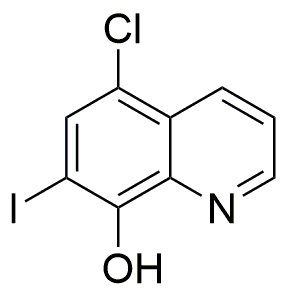5-Chloro-8-hydroxy-7-iodoquinoline is widely utilized in research focused on:
- Antimicrobial Research: This compound exhibits significant antibacterial properties, making it valuable in the development of new antibiotics. Researchers explore its effectiveness against resistant strains of bacteria.
- Antiparasitic Applications: It has shown promise in treating parasitic infections, particularly those caused by protozoa. This is crucial in fields like tropical medicine and veterinary science.
- Fluorescent Probes: The compound is used in the creation of fluorescent probes for biological imaging, allowing scientists to visualize cellular processes in real-time, which is essential in cellular biology and pharmacology.
- Drug Development: Its unique chemical structure aids in the design of novel therapeutic agents. Pharmaceutical companies leverage its properties to create more effective drugs with fewer side effects.
- Environmental Monitoring: The compound is also being researched for its potential use in detecting pollutants in water sources, contributing to environmental safety and public health initiatives.
Información general
Propiedades
Seguridad y normativas
Aplicaciones
5-Chloro-8-hydroxy-7-iodoquinoline is widely utilized in research focused on:
- Antimicrobial Research: This compound exhibits significant antibacterial properties, making it valuable in the development of new antibiotics. Researchers explore its effectiveness against resistant strains of bacteria.
- Antiparasitic Applications: It has shown promise in treating parasitic infections, particularly those caused by protozoa. This is crucial in fields like tropical medicine and veterinary science.
- Fluorescent Probes: The compound is used in the creation of fluorescent probes for biological imaging, allowing scientists to visualize cellular processes in real-time, which is essential in cellular biology and pharmacology.
- Drug Development: Its unique chemical structure aids in the design of novel therapeutic agents. Pharmaceutical companies leverage its properties to create more effective drugs with fewer side effects.
- Environmental Monitoring: The compound is also being researched for its potential use in detecting pollutants in water sources, contributing to environmental safety and public health initiatives.
Documentos
Hojas de datos de seguridad (HDS)
La SDS proporciona información de seguridad completa sobre la manipulación, el almacenamiento y la eliminación del producto.
Especificación del producto (PS)
La PS proporciona un desglose completo de las propiedades del producto, incluida la composición química, el estado físico, la pureza y los requisitos de almacenamiento. También detalla los rangos de calidad aceptables y las aplicaciones previstas del producto.
Certificados de análisis (COA)
Busque certificados de análisis (COA) ingresando el número de lote del producto. Los números de lote y de partida se pueden encontrar en la etiqueta de un producto después de las palabras "Lote" o "Lote".
Número de catálogo
Número de lote/lote
Certificados de origen (COO)
Este certificado de origen confirma el país en el que se fabricó el producto y también detalla los materiales y componentes utilizados en él y si se deriva de fuentes naturales, sintéticas u otras fuentes específicas. Este certificado puede ser necesario para cumplir con las normativas aduaneras, comerciales y regulatorias.
Número de catálogo
Número de lote/lote
Hojas de datos de seguridad (HDS)
La SDS proporciona información de seguridad completa sobre la manipulación, el almacenamiento y la eliminación del producto.
DownloadEspecificación del producto (PS)
La PS proporciona un desglose completo de las propiedades del producto, incluida la composición química, el estado físico, la pureza y los requisitos de almacenamiento. También detalla los rangos de calidad aceptables y las aplicaciones previstas del producto.
DownloadCertificados de análisis (COA)
Busque certificados de análisis (COA) ingresando el número de lote del producto. Los números de lote y de partida se pueden encontrar en la etiqueta de un producto después de las palabras "Lote" o "Lote".
Número de catálogo
Número de lote/lote
Certificados de origen (COO)
Este certificado de origen confirma el país en el que se fabricó el producto y también detalla los materiales y componentes utilizados en él y si se deriva de fuentes naturales, sintéticas u otras fuentes específicas. Este certificado puede ser necesario para cumplir con las normativas aduaneras, comerciales y regulatorias.


